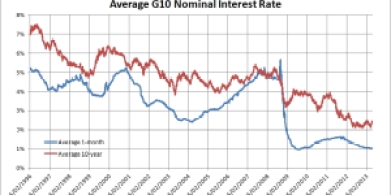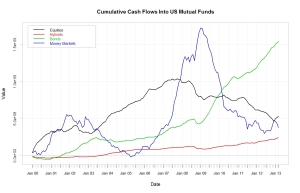I have been extremely fond of a bullish equity market scenario since early 2012. This play has now worked well despite talks of dislocation in Europe , Korea bellicosity, possible slowdown in China and other potential risk events. One of the triggers behind my view was an early realisation that the extremely loose monetary policy conducted by central banks would feed into an unsustainable bubble in the bond market and that this would activate a logical shift in both the private a public asset allocation preference.
Clearly, so far, central banks have been successful in bringing nominal and real rates to unprecedented levels and by the by have incentivised market agents to seek assets with higher returns and also higher intrinsic risks. Furthermore any upside in inflation will bring real rates even further in negative territory and bring another incentive for private and institutional investors to channel their capital resources toward riskier assets. This may prove a useful re-allocation of capital though it will create issues for central bank when the brunt of the shift take place as bond valuation may undesirably tumble. Meanwhile I would argue that despite the significant move we observed in equities over the last year , we have not yet seen the full delivered effect of this ultra-loose policy stance.
Investors response has been muted and we have not as of yet seen a significant asset allocation shift toward equities. This is well demonstrated by the data on US Mutual funds in flows compiled by the Investment Company Institute in the US. During the first quarter of this year we have started to see the premise of a what could become a significant move as private and institutional investors have become less sticky to their cash holdings and allocated some of their capital toward equities. However bond holdings remain at a level that statistically is highly non-normal.
Bearing in mind the low yield of the asset class, bettering growth in the US and public debate about the Fed exit policy, it becomes more and more difficult to ignore the bond bubble engineered by central banks. Also the attraction of greater excess returns that have been side-lined by most investors because of black swan and a “al la Roubini” doomsday scenarios becomes more tempting…. What may explain part of the move in stock markets so far is that companies are now more efficient due to their cutting costs ahead of expected difficult times. Therefore their stocks have been re-priced to reflect their stronger balance sheet and reduced borrowings. The price adjustment has not been led by a change in the investor inventory so far but by a new perception of their true fundamentals. The massive capital destruction that took place in 2008 conditioned investors, analysts and media to adopt a risk averse stance. Their financially induced behaviour remains proportionally sticky to the amount of pain endured and to some degree has been self feeding as reflected in past numbers of consumer confidence. Consequently the appetite for risk remains low for a long time due to the intensity of the capital erosion we experienced. The 2008 financial crisis created a self feeding mechanism where pessimism and formulation/expectations of doomsday scenario would become the rewarded norm. Economists became suspiciously short term in their views due to economic data becoming more volatile and therefore more difficult to forecast. Analysts and journalists got better rewarded for being a “Roubini” rather than isolated optimists. This change in behaviour has not delivered value to the end investor. Scaremongering drove investors to become sticky to their riskless assets and to ignore substantial excess returns that capital markets had in offer for them. Potential liabilities and fiscality risks drive institutional and private investors to reconsider their allocation of capital. In the one hand it would be reckless for pension funds not to reduce their bond exposures when the Fed start to debate their exit policy. Rising interest rate as central banks will withdaw liquidity potentially create significant short/medium term liabilities on their bond portfolios potentially inducing significant portfolio re-balancement. On the other hand rising fiscality by government seeking to replenish their coffers will drives private investors to demand higher returns. They will achieve this by investing in riskier assets and by going cross border to chase higher opportunities. My thought is that as the preference shift for stocks will take place we will see companies put this capital to work to capture new market opportunities and further invest into R&D. Exactly what governments and central banks want since it should generate new jobs. We are about to enter a long cycle where equities will dominate as the investors preferred asset class. As more cross-border investments will occur we will see stronger trend and higher volatility in currency markets which have been lacklustre over that last few years. I would expect the US Dollar to remain weak as much private capital in the US will seek diversifying opportunities… I ll stay long equities and definitively away from bonds for a good decade…





